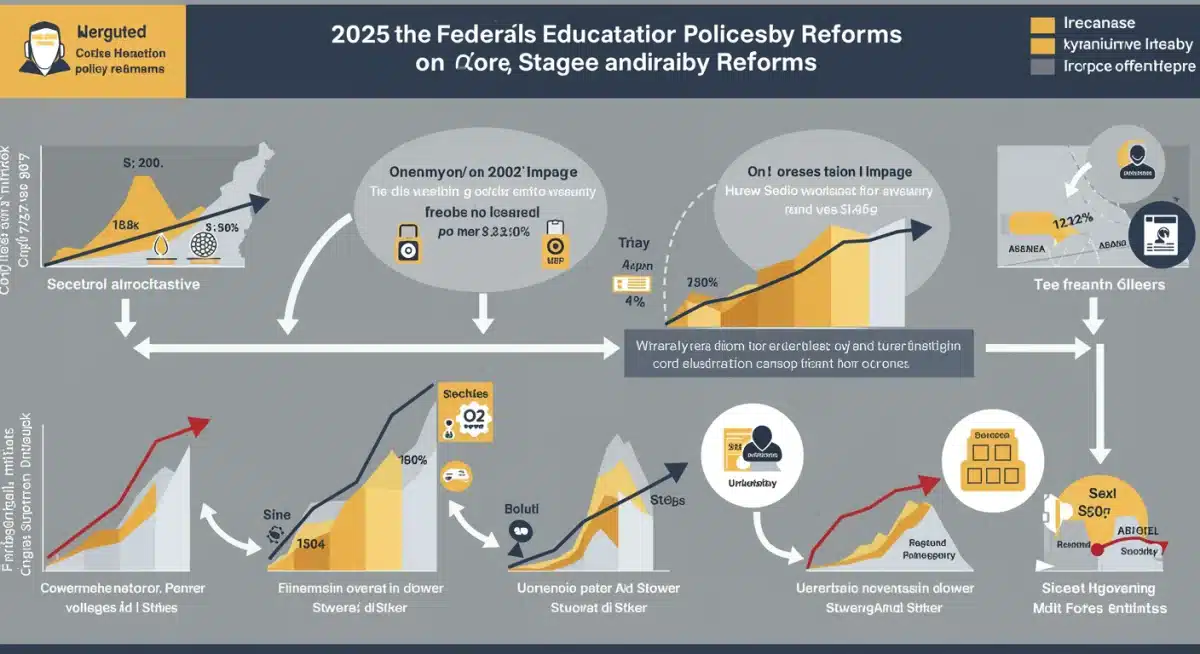2025 Federal Education Policy Reforms & College Affordability

New federal education policies for 2025 are poised to significantly reshape college affordability, with projections indicating shifts in student aid, loan programs, and institutional funding over the next year.
The Impact of 2025 Federal Education Policy Reforms on College Affordability: A 12-Month Projection is now coming into sharper focus, presenting both opportunities and challenges for students and institutions across the nation. What do these impending changes mean for your college plans?
Understanding the Core Policy Shifts for 2025
The federal government is introducing significant reforms to education policy slated for full implementation by 2025. These changes aim to address long-standing issues within higher education, particularly concerning access and cost. The reforms touch upon various aspects, from student loan programs to institutional accountability, signaling a new era for college financing.
As of late 2024, the Department of Education has finalized several key regulations that will govern financial aid distribution and institutional compliance. These measures are designed to streamline processes and, theoretically, make college more attainable for a broader demographic. However, the exact impact on individual students will vary based on their financial circumstances and chosen institutions.
Key Legislative Changes
Recent legislative actions, including the Higher Education Reauthorization Act updates and new executive orders, form the backbone of the 2025 reforms. These changes reflect a bipartisan effort to recalibrate the federal role in college funding and oversight.
- Federal Pell Grant Expansion: An increase in the maximum Pell Grant award is projected, aiming to cover a larger percentage of college costs for low-income students.
- Student Loan Interest Rate Adjustments: New formulas for federal student loan interest rates are being introduced, potentially offering more favorable terms for borrowers.
- Institutional Accountability Metrics: Stricter guidelines for colleges regarding graduation rates, job placement, and student loan default rates are set to be enforced, potentially affecting federal funding eligibility for institutions.
These policy shifts are not merely incremental adjustments; they represent a comprehensive overhaul intended to create a more equitable and transparent higher education landscape. Stakeholders, including universities, student advocacy groups, and financial aid officers, are currently analyzing these changes to prepare for their full effect.
Projected Impact on Student Loan Programs
One of the most keenly watched areas of the 2025 federal education policy reforms is the overhaul of federal student loan programs. For years, the complexities and rising costs associated with student loans have been a major barrier to college affordability. The new policies aim to simplify repayment, reduce interest burdens, and increase access to loan forgiveness programs.
Initial projections from the Congressional Budget Office suggest that these changes could lead to a net reduction in the financial burden for many borrowers, particularly those from lower-income backgrounds. However, the long-term fiscal implications for the federal budget are still being debated among economists and policy analysts.
Simplified Repayment Options
The Department of Education is consolidating existing income-driven repayment (IDR) plans into a more streamlined system. This new system is expected to offer more generous terms, such as lower monthly payments and faster paths to loan forgiveness for certain groups of borrowers.
- Revised Income Thresholds: Higher income thresholds for calculating IDR payments mean more disposable income for borrowers.
- Shorter Forgiveness Timelines: Forgiveness for undergraduate loans may be accelerated, potentially occurring after 10-20 years of payments, depending on the original loan amount.
- Automatic Enrollment: A pilot program for automatic enrollment in the most beneficial IDR plan is being explored, aiming to reduce administrative hurdles for students.
These changes are designed to prevent loan defaults and provide a clearer pathway out of debt for graduates. Advocates for student loan reform have largely welcomed these proposed adjustments, emphasizing their potential to alleviate significant financial stress.
Changes in Federal Grant and Scholarship Funding
Beyond loans, the 2025 federal education policy reforms are also bringing substantial amendments to federal grant and scholarship programs, most notably the Pell Grant. These grants are critical for students from low-income families, providing direct aid that does not need to be repaid. The goal is to enhance the purchasing power of these grants, making higher education more accessible without incurring debt.
The proposed increases in Pell Grant funding are a direct response to the rising cost of tuition and living expenses. This move signifies a renewed federal commitment to equity in education, aiming to close the gap between what students can afford and the actual cost of attending college.
Expanded Pell Grant Eligibility
Eligibility criteria for the Pell Grant are being reviewed and, in some cases, expanded to include more students. This could mean that more middle-income families might qualify for some level of assistance, broadening the reach of this vital program.
- Increased Maximum Award: The maximum Pell Grant award is expected to see a notable increase, providing more substantial financial relief.
- Year-Round Pell: Continued emphasis on year-round Pell Grant eligibility allows students to accelerate their degrees and reduce overall time to graduation.
- Simpler FAFSA Process: The Free Application for Federal Student Aid (FAFSA) is undergoing significant simplification, making it easier for students to apply for federal aid, including Pell Grants.
These enhancements are crucial for ensuring that financial barriers do not prevent deserving students from pursuing higher education. Universities are preparing to adjust their financial aid packaging to reflect these new federal allocations, hoping to attract and support a more diverse student body.
Impact on Institutional Funding and Accountability
The Impact of 2025 Federal Education Policy Reforms on College Affordability: A 12-Month Projection extends beyond individual students to the institutions themselves. New federal policies introduce more stringent accountability measures and alter funding mechanisms for colleges and universities. These changes are intended to encourage institutions to be more transparent about costs and outcomes, ultimately benefiting students.
Federal funding, including research grants and direct institutional support, will increasingly be tied to performance metrics. This shift could incentivize institutions to improve student success rates, particularly for underserved populations, and to control tuition increases more effectively.

Performance-Based Funding Models
Some federal funding streams will transition towards performance-based models, where a portion of an institution’s allocation depends on achieving specific benchmarks. These benchmarks often include graduation rates, retention rates, and post-graduation employment figures.
- Graduation Rate Benchmarks: Institutions with higher graduation rates, especially for Pell Grant recipients, may receive preferential federal funding.
- Student Outcome Reporting: Enhanced reporting requirements for student outcomes, including earnings trajectories, will provide greater transparency for prospective students.
- Tuition Control Incentives: Policies may offer incentives or penalties related to tuition increases, encouraging colleges to keep education affordable.
These measures aim to ensure that federal taxpayer dollars are invested in institutions that deliver tangible value and positive outcomes for their students. Colleges are now actively reviewing their strategic plans to align with these new federal expectations.
The Role of State and Local Initiatives
While federal policies set a broad framework, state and local initiatives play a crucial complementary role in shaping college affordability. The 2025 federal reforms are expected to interact with existing state programs, potentially creating new synergies or highlighting areas where further coordination is needed. Many states are already developing their own strategies to enhance access and reduce costs for their residents.
This interplay between federal, state, and local efforts is vital for a holistic approach to affordability. States with robust grant programs or tuition freezes may amplify the positive effects of federal reforms, while others may need to adapt their strategies.
State-Level Grant Programs
Many states offer their own grant programs that supplement federal aid. The increased federal Pell Grant funding might free up state resources, allowing them to support a wider range of students or provide additional aid to those with the greatest need.
- Matching Fund Opportunities: Some federal programs may offer matching funds to states that invest in their own college affordability initiatives.
- Tuition Promise Programs: Several states are exploring or expanding ‘tuition promise’ programs, guaranteeing free tuition for eligible students at public institutions.
- Community College Funding: Enhanced federal support for community colleges could lead to increased state investment, making these institutions even more affordable.
Local initiatives, such as scholarships from community foundations or partnerships between high schools and local colleges, also contribute significantly to reducing the financial burden on students. These localized efforts often address specific regional needs and demographics.
Anticipated Challenges and Unforeseen Consequences
While the 2025 federal education policy reforms are largely designed to improve college affordability, new policies often come with anticipated challenges and unforeseen consequences. Stakeholders are closely monitoring how these changes will unfold over the next 12 months, preparing for potential hurdles that could impact students and institutions alike.
One primary concern revolves around the administrative burden on colleges to implement the new regulations. Smaller institutions, in particular, may struggle to adapt quickly to complex reporting requirements and updated financial aid processes, potentially delaying benefits for students.
Potential Implementation Hurdles
The sheer scale of the policy changes means that smooth implementation across thousands of institutions nationwide will be a significant undertaking. Discrepancies in understanding or applying new guidelines could lead to inconsistencies in aid distribution.
- Technological Infrastructure Updates: Colleges will need to invest in updating their financial aid and student information systems to comply with new federal mandates.
- Staff Training Requirements: Financial aid officers and administrative staff will require extensive training on the revised FAFSA, loan programs, and accountability metrics.
- Communication Gaps: Ensuring clear and timely communication to students about the new aid opportunities and application processes will be crucial to avoid confusion.
Furthermore, there is a risk that some institutions might respond to stricter accountability measures by reducing access for certain student populations, such as those deemed less likely to graduate or repay loans, inadvertently undermining the goal of increased equity.
| Key Policy Area | Projected 12-Month Impact |
|---|---|
| Pell Grants | Increased maximum awards and expanded eligibility for low-income students, enhancing direct aid. |
| Student Loans | Simplified income-driven repayment plans and potential for faster loan forgiveness, reducing borrower burden. |
| Institutional Accountability | Stricter performance metrics tied to federal funding, pushing institutions for better student outcomes and cost control. |
| FAFSA Simplification | Streamlined application process for federal financial aid, making it easier for students to access support. |
Frequently Asked Questions About 2025 Education Reforms
Existing federal student loans may be eligible for new income-driven repayment plans, potentially offering lower monthly payments or a faster path to forgiveness. Borrowers should monitor updates from the Department of Education for specific details on how to transition to new plans.
Yes, projections indicate an increase in the maximum Pell Grant award and expanded eligibility. This aims to cover a greater percentage of tuition and living expenses, offering more substantial financial assistance to eligible students starting with the 2025-2026 academic year.
The FAFSA process is undergoing significant simplification, including fewer questions and a more direct data exchange with the IRS. This aims to make applying for federal student aid easier and less time-consuming for students and families, improving accessibility.
Colleges will face stricter accountability measures tied to federal funding, focusing on student outcomes like graduation and employment rates. This encourages institutions to prioritize student success and manage tuition costs more effectively, potentially leading to improved educational quality.
Potential challenges include increased administrative burdens for colleges, requiring technology updates and staff training. There’s also a risk of institutions inadvertently restricting access for certain student groups to meet new performance metrics, though policies aim to prevent this.
Looking Ahead: The Evolving Landscape of College Affordability
The Impact of 2025 Federal Education Policy Reforms on College Affordability: A 12-Month Projection indicates a significant pivot in how higher education is funded and accessed. As these policies take full effect, the coming year will be critical for observing their real-world outcomes. Stakeholders will be closely watching for how institutions adapt, how students benefit from increased aid, and whether the administrative challenges can be effectively navigated. The ultimate goal remains to make college a realistic and affordable option for all aspiring students, fostering a more educated and competitive workforce.





